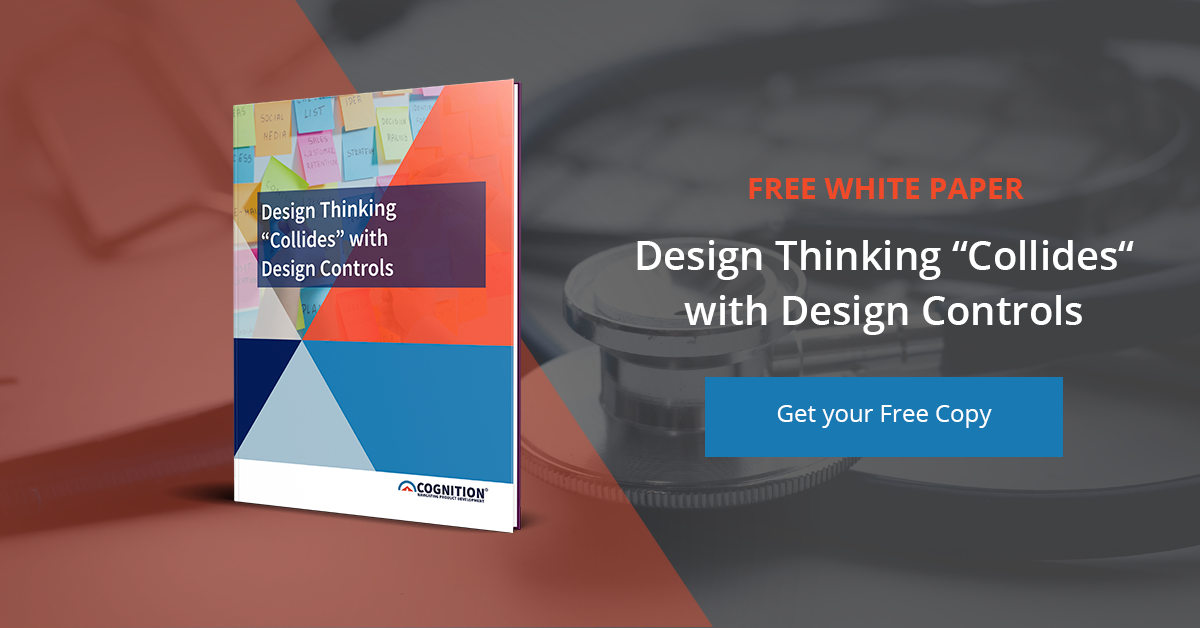How Can Design Thinking Impact Design Controls?
Many life science organizations treat design thinking and design controls as separate product development stages. In reality, they can overlap; while this feels counterintuitive to some, it’s actually an important point that teams need to manage. For a more robust product development process, your teams should be thinking about how to use these two aspects of product development together. How design thinking can impact design controls is valuable to understand and evaluate as part of your organization’s plans for long-term growth.
Capturing Valuable Insights
Design thinking can be highly productive in depicting ideas related to your life science products. Tools such as journey mapping and storyboarding can identify user needs and customer voices that can influence the scope of your development activities. By seeing what these needs look like and the context in which they occur, you can make better decisions about your product design.
 When it comes to transitioning from innovation stages to design controls, the benefit of well-informed, contextual product insights might not seem apparent at first. However, they can be absolutely vital for your compliance activities. Consider what 21 CFR 820.30 says about design inputs: they must be “appropriate and address the intended use [...], including the needs of the user and patient.” Design thinking tools that identify conceptions about your life science product directly speak to this regulatory requirement.
When it comes to transitioning from innovation stages to design controls, the benefit of well-informed, contextual product insights might not seem apparent at first. However, they can be absolutely vital for your compliance activities. Consider what 21 CFR 820.30 says about design inputs: they must be “appropriate and address the intended use [...], including the needs of the user and patient.” Design thinking tools that identify conceptions about your life science product directly speak to this regulatory requirement.
Looking at the language of the design inputs regulation can help us understand the value of design thinking. FDA wants to see that all inputs identified in the design process are appropriate, as well as aligned with the intended use and your user needs. The alignment aspects are easy enough to take care of, but how do you know that any given design feature is “appropriate”? There’s a lot of gray area with this regulatory language, but that’s where design thinking fits in. When thoroughly utilized, design thinking tools generate data that supports the inclusion and development of any given input into the product design.
Controlling Development Issues Earlier
 Design issues can occur at any point during the development process. However, as it progresses, the resulting remediation and rework to deal with these concerns becomes more error-prone and time-consuming. To mitigate the number of issues that could occur, as well as the potential of their occurrence, life science organizations can take advantage of the overlap between design thinking and design controls.
Design issues can occur at any point during the development process. However, as it progresses, the resulting remediation and rework to deal with these concerns becomes more error-prone and time-consuming. To mitigate the number of issues that could occur, as well as the potential of their occurrence, life science organizations can take advantage of the overlap between design thinking and design controls.
When the rigor of design controls is applied to design thinking data, it is easier to detect risks and other issues that could impact later-stage development. Likewise, early phase design thinking activities such as rapid prototyping can identify proposed ideas and solutions that may negatively impact the product design. Especially if these design thinking tools are used in an iterative fashion with design controls activities, the relationship between innovation and compliance can be used to great effect in the development process.
Streamlined Data Transitions
 When carefully managed, design thinking tools and activities make the transition of new data to the rigor of design controls easier. Plus, they allow for a more systematic approach that allows your teams to move back and forth between innovation and compliance stages. Because these phases of product development work in tandem rather than separate, isolated sequences, having that ability to transition between each can be useful over the long term.
When carefully managed, design thinking tools and activities make the transition of new data to the rigor of design controls easier. Plus, they allow for a more systematic approach that allows your teams to move back and forth between innovation and compliance stages. Because these phases of product development work in tandem rather than separate, isolated sequences, having that ability to transition between each can be useful over the long term.
Why Design Thinking Matters
Design thinking is a powerful approach to innovation in life sciences, but it’s also an effective methodology for compliance. When focused on generating creative ideas and solutions, design thinking—when appropriately paired with the right design controls activities—can transform your product development. Innovation and compliance can go hand in hand, and by recognizing this, life science organizations can adopt leaner and more user-focused approaches to building life science products.
About Cognition Corporation
At Cognition, our goal is to provide medical device and pharmaceutical companies with collaborative solutions to the compliance problems they face every day, allowing the customer to focus on their products rather than the system used to create them. We know we are successful when our customers have seamlessly integrated a quality system, making day-to-day compliance effortless and freeing up resources to focus on product safety and efficacy.





